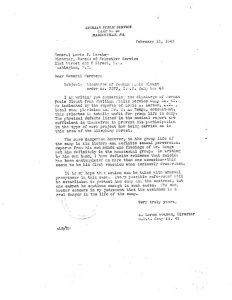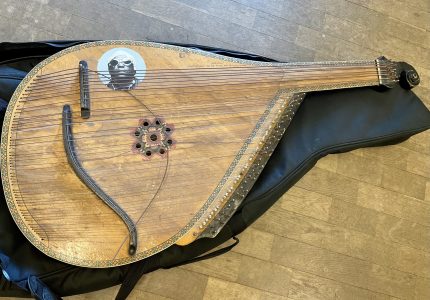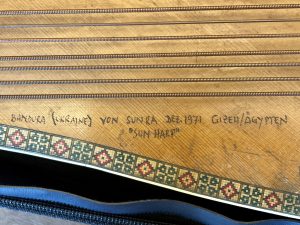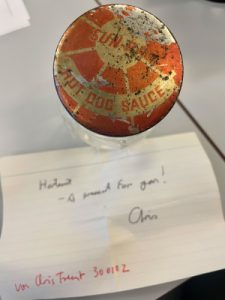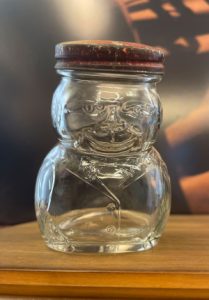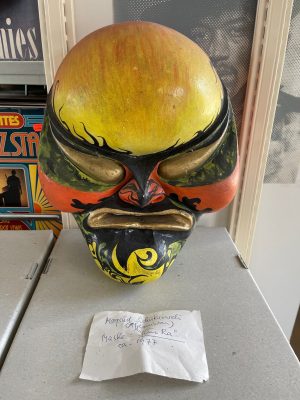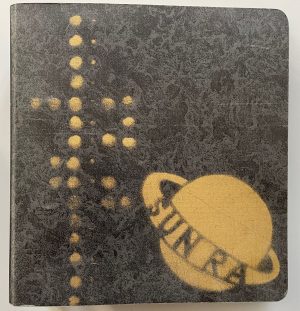In May 2021, we took over the Sun Ra Archive of writer, cultural coordinator and researcher Hartmut Geerken. It is the world's most comprehensive private archive on the life and work of the U.S. free jazz pioneer and mastermind of Afrofuturism. The collection includes tape recordings of nearly 500 previously unpublished concerts, interviews and rehearsals of the Sun Ra Arkestra, film recordings on more than 70 videotapes or DVDs, Sun Ra's entire poetic œuvre, some with corrections in his own hand, 1,200 photographs, a comprehensive archive of secondary literature, correspondence with leading Sun Ra researchers as well as with Sun Ra himself, which Geerken used for his extensive books "Omniverse Sun Ra" and "The Immeasurable Equation," and much more.
"Hartmut Geerken's Sun Ra archive is a great and important addition to the Jazz Institute's collection," our Lord Mayor and Head of the Department of Culture Jochen Partsch stated at the time. "Sun Ra was a pioneer of the Black Power movement of the 1960s and thus also of the Black Lives Matter movement of our time. The collection of Geerken who knew Sun Ra personally and was friends with many of the musicians in his Arkestra, documents how Sun Ra foresaw Afrofuturism that reverberated in George Clinton's music in the 1970s and became part of the international discourse of cultural criticism from the 1980s on.
In the meantime, we have digitized far more than half of the huge collection; written documents as well as film or audio recordings of his concerts. And the archive is already attracting researchers from all over the world - in March 2023, for example, we hosted a researcher for a documentary planned on Sun Ra by renowned U.S. director Stanley Nelson (cf. Hollywood Reporter). Geerken himself was happy that his collection found a home in Darmstadt, of all places. A radio broadcast by jazz expert Joachim Ernst Berendts, whose estate forms the basis of the archive at the Jazzinstitut, had brought Sun Ra to his attention in the early 1960s, he told us in one of the last telephone conversations we had with him. Only a week later, Geerken died completely unexpectedly in October 2021 at the age of 82 in his home on the Ammersee.
Sun Ra is not only of interest to music historians, but also and particularly to young musicians, who are fascinated by the visions of the bandleader and composer. As early as in the 1950s he succeeded in combining tradition and avant-garde. Ra had his roots in the big band music of the swing era, but quickly became one of the pioneers of freer paths in jazz. The concerts of his Arkestra, some of which lasted for hours, and the contemplation of old African rituals came alive with the colorful costumes, the performance, which always included the audience, and with the rousing hymns that sounded between free improvisations and swinging arrangements. Last but not least, Ra was also a pioneer of electronic music, one of the first musicians to use the Moog synthesizer for live concerts. And in 1986 - another Darmstadt reference - he met the mastermind of new music John Cage at a joint concert in New York.
Sun Ra's music has accompanied us ever since. We marvel at the farsightedness of his aesthetics, and thus it is not without reason that we have given the 18th Darmstadt Jazz Forum, where we will be discussing "the future of jazz" in September 2023, a title from Sun Ra's discography: "Destination Unknown".
"Space is the Place" was the name of one of the reverberating hymns sung by the Arkestra in its concerts. The Darmstadt Jazz Institute has cleared enough "space" on its shelves to make room for the documents about one of the most dazzling and outstanding figures of African-American music.
Here are a few examples from the collection:
Prison correspondence
Herman Poole Blount, as he was then known, spent the first 30 years of his life in Birmingham, Alabama, where he was born in 1914. In 1942, he was drafted into military service, which he refused for religious reasons, among others. He served several months first in an Alabama prison, then in a Pennsylvania camp, where he was diagnosed as suicidal as well as "homosexual". Geerken collected copies of Blount's correspondence from those years, in which he speaks candidly about his health problems, but also his sexuality.
The Sun Harp
In Geerken's words (Giza, Egypt, December 1971, from: Omniverse Sun Ra):
the night they were to leave i watched sonny, the chief, sitting behind a little table in the hotel hall. a lit candle in front of him illuminated rows of numbers on a piece of paper. my first thought; magic nurnbers, astrology. but then i heard that there wasn’t enough money to pay the hotel bill. the telephone bill was immense, too. his 21 musicians had made lots of phone calls, like they always did when they were on tour. i know for a fact that once sonny paid the telepone bill amounting to over 1000 dollars with a professional tape, including the rights. – even though it was late at night, i tried to get arabian & german friends to participate in the bill so that sonny & his crew could leave for the airport. they had to pay to be able to leave the building. my friends were reluctant, so i chipped in as much as i could, but it wasn’t enough. one of them kept sneaking outside with something & returning without whatever it was & then handing a few money bills to sonny. sonny would then start adding again. i think june even sold some of her jewelry. she kept laughing & saying: ‘that’s too much! that’s too much!’ sonny didn’t seem too upset about the precarious situation. how often had he gone through this before? the intergalactic constellation cannot be measured by the standards of earthly time… at some point patrick arrived with a large string instrument, a ukrainian bandura & extra strings to replace the lower strings, handed them to sonny & sonny handed them to me, sort of as a security for the rnoney i had given to him. some tirne when he had rnoney, he said, he would ask me to return the instrument, it was his famous sun harp (“STRANGE STRINGS”).
The Sun Harp can be heard on numerous recordings, for example in "Solar Symbols". Geerken plays it in 1996 on his "Sun Ra Tribute" album; "Sunny’s Sun Harp“.
Sun Ra Hot Dog Sauce
Chris Trent, Geerken's collaborator on the second edition of "Omniverse - Sun Ra", sent Geerken this bottle one day. It has nothing to do with "our" Sun Ra, was a popular ingredient in the 1940s for ... "Hot Dogs.
Maqsud Schukurwali
Geerken's encounter with Sun Ra radiated to everyone he dealt with. Maqsud Shukurwali played guitar in Geerkens Rock and Free Jazz Groupwhen he worked for the Goethe-Institut in Afghanistan in 1976. Shukurwali otherwise works as a graphic artist and visual artist; from 1977 comes his mask with the name "Sun Ra".
Discographies
"Omniverse - Sun Ra" is, after all, everything: biography, discography, poetry collection, musical classification, reflection on... The basic research for all this, however, was endless correspondence that Geerken conducted with other Sun Ra collectors from all over the world, active participation in mailing lists, the organization of regular Sun Ra conferences. Robert Campbell's "The Earthly Recordings of Sun Ra" (second edition: 2001) is the "bible" for Sun Ra collectors, but Geerken's collection also includes all predecessors back to Otto Flückiger's discography in the journal "jazz-statistics" from 1961. A particularly beautifully designed work is Tilman Stahl's privately published "Sun Ra Materialien / Sun Ra Materials" from 1983.
The Sun Ra collection comprises much more - we will come back to this and describe further individual folders and boxes when the opportunity arises, for example the bundle of sheet music or tape cassettes. Oh, one more thing: Even the material that has already been digitized is not available online, but can only be used for research purposes at the Jazzinstitut itself.
(Wolfram Knauer, März 2023)

